Biomes have profoundly shaped human history
Or, the most important map that you will ever see.
Make someone’s day: Gift a subscription to your friends and family!
This is my second post on the role of geography in the history of human material progress. I would recommend reading the previous post on the topic first.
See also my articles on related topics:
Most of the following is an excerpt from my first book From Poverty to Progress: Understanding Humanity’s Greatest Achievement. You can order my e-books at a discounted price at my website, or you can purchase full-price ebooks, audiobooks, paperback, or hardcovers on Amazon.
Other books in my “From Poverty to Progress” book series:
Biomes
Our quest to find geographical factors that promote and hinder progress must start with biomes. Susan Woodward’s eight-book series Greenwood Guides to Biomes of the World has done much to extend our knowledge on this subject.
A biome is a category for a geographical area based upon its dominant vegetation. The dominant vegetation in any area sets very broad constraints on what type of plants and animals can evolve there. The dominant vegetation sustains the local herbivores, which then sustain the local carnivores. Since humans use a portion of these plants and animals as base materials for food production, biomes also play a critical role in constraining the types of human societies that can develop within them.
The concept of biome has recently been systematized by the World Wildlife Fund (WWF), an organization dedicated to understanding the diversity of life on planet Earth. The WWF’s system divides the earth into 14 different biomes containing 867 smaller ecoregions. Biomes are determined by many geophysical and meteorological factors, including latitude, elevation, ocean currents, prevailing wind, rainfall, and seasonality.
One example of a biome is the Temperate Grassland biome. Not surprisingly, grasses dominate this biome, and the biome is located within the temperate latitudes. The California Central Valley and Mongolian-Manchurian grassland are ecoregions. Each of these ecoregions is an instance of the Temperate Grasslands biome. While these two ecoregions differ from each other, they share far more in common.
The WWF biome categorization is an internationally recognized system for understanding wild plants, animals, and their ecosystems. Unfortunately, those who study human societies have not used systematic analysis of biomes.
I believe that this is a big oversight by social scientists and historians. The fact that the WWF system was developed without reference to human societies means that it gives us a relatively objective view of geography; one that can be used to look for patterns in human development.
When one compares the WWF map to human population density maps for any given point in history, one can discern clear patterns. Very few of the biomes have been able to support large population densities until recently, and even fewer have been able to support the complex societies that drive innovation and progress.
Only a Few Biomes Made Progress Possible
To understand why a society is rich or poor today, we must first look at the geography of their ancestors. Biomes are not the only geographical constraint, but they are the most important.
I will go into more detail in subsequent posts, but the short story is that for humans to experience progress, they first needed to create complex societies. By complex societies, I mean Agrarian or Commercial societies. It was only in those types of societies that was it even remotely possible to grow enough food for everyone to experience at least some progress. And those society types could only evolve in a few biomes.
Humans living in all other biomes were trapped in poverty by geographical constraints forever… or at least until the Industrial Revolution created an escape clause. And these geographical constraints created a legacy that is still seen on the map at the top of this post.
Biomes That Made Progress Impossible In The Past
First of all, no large permanent human settlements have ever existed in any of the Ocean biomes. Since oceans cover about 70 percent of the planet, this eliminates a huge portion of planet Earth from human habitation.
Even with 21st Century technologies, our interactions with the ocean consist entirely of short-term voyages for transport and fishing. While the ocean provides resources for many land-dwellers who are brave enough to voyage upon it, it is more hostile to human habitation than even the driest deserts.
Polar and Highlands biome
The ice-covered Polar regions and the Highlands regions over 12,000 feet in altitude are also almost devoid of human habitation. Eskimos and Inuits have learned how to live in the polar biome, but their population sizes are very small. Both cultures have developed Fishing societies that subsist primarily by hunting marine mammals, such as seals and whales. Even these highly specialized cultures have only been able to survive on the edge of Polar regions.
While modern scientists, explorers and adventure enthusiasts sporadically visit them, these regions are not much more hospitable than the ocean. It is clear the Polar regions and mountains over 12,000 feet in altitude cannot create a food surplus to support high population densities, cities and rapid technological innovation. Even the simplest forms of agriculture are impossible.
Tundra biome
Somewhat more hospitable are Tundra biomes. Tundra biomes are largely confined to the very northern edge of Asia and North America. The dominant vegetation in the Tundra biome is ground-hugging vascular plants, mosses, and lichen. The only large grazing animals are caribou/reindeer and musk ox.
Temperatures on the Tundra are above freezing for only 6-10 weeks per year, causing a very short growing season. Even worse, just a few inches below the surface is a thick layer of permafrost, which is essentially frozen soil. This permafrost layer makes it impossible for tree roots to anchor in the soil.
The result is a biome that cannot support trees. This creates a major constraint on human habitation. Without trees, wood cannot be used for the construction material, tools, heating of homes or smelting metals. And without trees, there is no natural shelter from the dry arctic winds, so even bushes cannot survive.
Because of the very limited plant growth in the Tundra biome, only two types of human societies have been able to survive there: Fishing societies that subsist on marine mammals (similar to Polar regions) and Herding societies that subsist by herding reindeer. Not surprisingly, these types of societies cannot generate food surpluses that support the high human population densities needed for innovation and progress.
Boreal Forest biome
Progressing southward through the Northern Hemisphere, we come to the Boreal Forest biome of Siberia, Canada and Northern Scandinavia. While most Boreal ecoregions are in the far north, some extend southward along mountain ranges.
Regardless of location, the winter temperatures in Boreal Forests are very cold, and the summer growing season is very short. Up to six months per year see below-freezing temperatures. While the biome experiences 15-20 inches of precipitation per year, most of that precipitation falls in the summer as rain.
Conifers dominate the Boreal Forest biome. Conifers are trees covered by needles, rather than leaves. Whereas tropical biomes have a huge variety of plants, enormous tracts of Boreal Forest are typically covered by only two or three species (usually a variety of pine, spruce, fir or larch).
In very cold climates with short growing seasons, needles on conifer trees offer many advantages over leaves. The dark green color of most needles absorbs a wider spectrum of wavelengths of sunlight, while their waxy coating traps scarce water inside the plant. Conifers can also start producing sugar via photosynthesis as soon as the late northern spring starts without having to devote energy towards regrowing leaves. Finally, their conical shape helps to shed the deep winter snow.
The biggest disadvantage of conifer trees for other species, including humans, is that needles decay very slowly. The combination of thick waxy needles and a very limited amount of decomposing bacteria and animals in the region means that a thick layer of dried needles usually covers the topsoil. This interferes with seedlings’ growth, creating “dead zones” with at most a few saplings or shrubs immediately below each large tree. These mats cause the soil to become highly acidic and unproductive for plants or agriculture.
Conifer needles, except for the buds that bloom in the spring, are also not very nutritious for animals. Therefore, very few boreal animals eat needles. Most Boreal mammals and birds subsist on seeds, nuts, leafy plants in bogs or by eating herbivores.
Boreal forests consist of enormous stands of almost identical trees. Pools of water and lightning strikes cause the only real variation in Boreal regions: the landscape is dotted by a myriad of burn sites, rivers, bogs and lakes in the spring and summer. These open, wet regions create Tundra-like micro-regions that support leafy plants during the spring and summer.
Hunter-Gatherer societies and a few isolated Fishing societies are the only types of human societies that have inhabited Boreal regions. Because of the lack of edible plants and unproductive soil, societies in this biome subsist heavily on hunting moose and trapping weasels, beavers and other fur-bearing animals. None of these food sources can support the large dense populations needed to promote innovation and progress. Just like the Polar and Tundra biomes, the Boreal Forest biome sets a hard ceiling on the level of development that humans can achieve without outside help.
Temperate Grassland biome
The next biome on our trip southward is the Temperate Grassland biome. The bulk of this biome is located in Central Asia and North America, but smaller Temperate Grassland ecoregions exist in Argentina, Australia, and the Middle East. As its name implies, grasses and forbs dominate the Temperate Grassland biome. Other characteristics of this biome include a semi-arid climate with 10-20 inches of rain per year, a cold winter, and a hot summer.
While trees find this combination of climatic factors hostile, grasses thrive in it. Ten million years ago, when the climate was much warmer, grasslands did not exist in large enough concentrations to be considered a biome. But as the climate gradually cooled and dried, grasses began to establish local footholds. About 4-6 million years ago, conditions were sufficiently cool for grass biomes to evolve. The tough, hardy grass grew rapidly at the expense of tropical forests.
Not by coincidence, this is exactly the period when our primate ancestors first ventured out of the trees and moved into the grasslands. Without the evolution of Grassland biomes, it seems very unlikely that humans would have existed at all.
The key characteristic that distinguishes grasses from trees and bushes is that the bulk of their organic content is in their roots below the soil. While trees and most other large plants grow upward to access as much of the sun as possible, grasses grow downward in their roots. This makes grass extremely resistant to cold, fire and grazing. While parts of grass may be destroyed above the surface, their deep root system traps moisture and uses that moisture for regrowth.
It seems likely that fire has been the most potent ally of grass in its endless battle with trees. Random lightning strikes or even fires deliberately created by humans would have had a devastating effect on trees, but little effect on the largely underground grass.
Each tree that dies would be quickly swarmed by new grass shoots, which would grow a dense network of roots so fast as to starve any tree saplings that might attempt to grow back. In this way, grasses living in dry climates have gradually advanced at the expense of trees.
Temperate Grasslands have low levels of plant diversity; they are often covered by hundreds of miles of only a few species of grass. Whichever types of grass are best adapted for a locale usually grow so thick that they choke out most other plants. This in turn forces all local herbivores to evolve to digest those species efficiently.
Temperate Grassland animals consist of grazing herbivores and the carnivores that hunt them. While this leads to low levels of animal diversity, the biome supported the native wild ancestors of the domesticated animals necessary to support agricultural societies.
Just as important, the grasses themselves evolved into the ancestors of staple crops that form the bedrock of agricultural societies: rice, wheat, oats, rye, millet and others. Grasses have been the biological foundations upon which complex societies have been built.
With all of these biological advantages, one might think that Temperate Grasslands could support advanced Agrarian societies. Unfortunately, grass has one huge disadvantage for humans: their dense mat of roots is so thick and deep as to be almost impossible to plow.
While the soil is usually extremely productive, it is so hard to work that most farmers give up and move elsewhere. Until the invention of the steel plow in the 1830s, most agriculture in the Temperate Grassland biome was restricted to isolated regions where the sod was naturally broken by riverbeds.
The dominant type of human society in the Temperate Grasslands biome has been the Herding society. Humans in this society type subsist by herding large herds of herbivores: horses, cattle, sheep and goats. Those animals enabled humans to exploit the largest energy source of the grassland: cellulose. By eating animals that could digest cellulose, the bulk of grass material, humans were able to live in an otherwise hostile environment.
The horse has been the most important of all herd animals to human development. Horses have provided three critical resources for human societies. At first, horses functioned mainly as a food source, not that different from cattle. Early Herding societies probably ate horsemeat. More importantly, horses provided the most rapid form of transportation in the pre-Industrial era. Finally, Agrarian societies learned how to harness horsepower to pull plows, carts and wagons.
But ultimately, the Temperate Grasslands biome placed a hard ceiling on the type of human societies that could develop. Where large domesticable animals existed, as in Asia, Herding societies could evolve. Where large domesticable animals did not exist, as in North America, South America, and Australia, humans could not evolve beyond Hunter-Gatherers. Regardless, productive agriculture capable of supporting densely populated cities was not possible until after 1830. This ultimately undermined the amount of human progress that could take place in these regions until that date.
Desert biome
Another biome that was historically dominated by Herding societies is the Desert biome. Deserts are defined by annual precipitation of fewer than 10 inches per year. With so little moisture, trees have a hard time living, so smaller shrubs dominate. Desert shrubs usually have very small leaves to preserve moisture, and many are covered in spines or thorns. These shrubs have shallow but wide root systems to capture infrequent rains and long, deep taproots to gather groundwater deep under the surface. Many other desert flowers lie in seed until rainfall is high, causing a spectacular desert spring.
The only Desert plants that are useful to humans are perennial forbs that store their moisture and nutrients in bulbs and rhizomes. These forbs are much sought after by Hunter-Gatherer peoples in the Desert biome.
The lack of water and hot temperatures make it extremely hard for mammals to live in the desert. The desert is reptile country, as these animals can use the sun to warm their bodies and their slow metabolism means that they can survive without eating for long periods.
One species of mammal did find a way to survive and prosper in this hostile environment and became a cornerstone for Desert Herding societies: the camel. With their ability to pack heavy loads across long distances without regularly drinking water, camels have been indispensable for long-term survival in Desert ecoregions.
The only Agrarian civilizations in Desert biomes were those that evolved on large rivers in Southwest and Central Asia. Those societies exploited this unusual niche to grow vast amounts of wheat, rye, millet and other grains. Those grains enabled some of the earliest Agrarian societies to evolve: Egypt, Mesopotamia, the Indus river valley and scattered cities throughout Central Asia. But the riverine nature of their societies placed hard geographical constraints that meant they were weaker than Agrarian societies in other biomes.
Tropical Grassland biome
A third biome that has been dominated by Herding societies for centuries is the Savanna biome (or Tropical Grasslands). Africa has the most famous Savanna ecosystems, but South America and Australia also have substantial ecoregions of that type. These regions are in tropical latitudes that experience less than five inches of rain for at least five months per year. Just as in the Temperate Grasslands, this level of rainfall creates a perfect habitat for grass.
Unlike the Temperate Grasslands biome, the Savanna supports a large variety of herbivores. Each species has evolved its own specialized means of consuming grass: some prefer different heights or species of grass; some prefer grazing at a specific time of day or time of year. And the large predators of the Savanna have also evolved specialized means for hunting these grazers.
With all of these large herbivores, one might think that there were plenty of options for domestication. Unfortunately, Savanna herbivores are often aggressive and ill-tempered, making domestication impossible. Horses, cows, pigs, sheep, goats and other domesticated mammals all originated in Temperate latitudes.
This created a major barrier to the evolution of both Herding and Agricultural societies on the Savanna. Not until cattle diffused from the Nile River valley were Herding societies able to evolve on the African savanna. Because they lacked domesticable animals, the Savanna ecosystems of South America and Australia did not evolve beyond Hunter-Gatherer societies until recently.
Tropical Rain Forest biome
About 50 million years ago, when the planet was significantly warmer, the Tropical Rain Forest biome dominated planet Earth. Flowering plants, the dominant vegetation in Tropical Forests first evolved during the Cretaceous, the last period inhabited by dinosaurs. Some scientists believe that it is was the emergence of flowering plants that led to the tremendous variety of dinosaur species during that period. The most famous were Triceratops and Tyrannosaurus Rex.
The Chicxulub meteor impact, which drove the dinosaurs to extinction and enabled mammals to become the dominant animal form, also enabled flowering plants to largely replace the conifers that had dominated during the dinosaur era. The gradual cooling and drying of the climate over the last 50 million years caused Tropical Forests to contract numerous times, including during modern times.
Today Tropical Rain Forests cluster very close to the equator at elevations below 1000 meters. The bulk of the ecoregions of this type is in Southeast Asia, Amazonia and the Congo, although smaller ecoregions exist in West Africa, India, Central America and Southern Brazil.
Huge broadleaf evergreen trees that can grow to a height of 100 feet dominate the Tropical Rain Forest biome. Below them exist at least four more layers of canopy. The floor of these forests is usually open ground, due to the lack of sunshine on it. Without this sunshine, few plants can grow. This means most food sources are high up in the trees – most inconvenient for ground-dwelling humans.
Unlike all other biomes, there is very little variation in heat, moisture, sun angle or day length from day-to-day or even season-to-season. This means that each plant species was free to evolve a flowering and fruiting season at widely differing times of the year.
Strangely, the key constraining resource in the Tropical Rain Forest is sunlight, because the tallest trees block the sun from hitting other shorter plants. This causes plants to compete against each other for sunlight by growing upward.
Tropical Rain Forests are a biome with a staggering variety of plant and animal species. While Temperate biomes tend to have a small number of species over a large land area, one can find hundreds of plant and animal species within a single square mile in Tropical Rain Forests.
One might think that, given the number of wild plant species, humans would have a cornucopia of domesticated plants. While there are many native wild ancestors of domesticable plants in the Tropical Rain Forest, staple crops, which tend to be grasses, are notably lacking. Humans in the Tropical Rain Forest mainly subsist on root vegetables: cassava, aroids, sweet potatoes and yams. These crops are far more difficult to preserve and transport than the grains grown in temperate latitudes.
Even worse, Tropical Rain Forests tend to have unproductive soils. The nutrients are trapped in leaves that never fall to the ground. The high heat and moisture have leached most of the nutrients from the soil. The high number of decomposing species in the soil means that the nutrients from fallen trees and shrubs do not penetrate into the soil.
Unfortunately for humans, most of the animal species in Tropical Rain Forests spend all or almost all of their time high up in the trees to gather wild fruits and avoid predators on the ground. Until the invention of the bow-and-arrow, hunting in the jungle was a poor method of supporting one’s family. For this reason, human societies in the Tropical Rain Forest generally subsist on root vegetables and fish with only small amounts of calories coming from hunting.
While the Tropical Rain Forest is a rich haven of biological diversity, it places serious constraints on the types of human societies that can evolve. Only Hunter-Gatherer, Fishing and Horticultural societies have been able to evolve in this biome. None of them are capable of supporting the highly productive agriculture needed to create densely populated cities.
Tropical Seasonal Forest biome
Closely related is the Tropical Seasonal Forest biome. This biome shares much in common with the better-known Tropical Rain Forests, with but one very important difference. While Rain Forests experience high rainfall year-round, Seasonal Forests have a distinct Dry season, usually for four to seven months.
While Rain Forests hug the equator, Seasonal Forests generally live between latitudes 10 and 25 (i.e. just north and south of the Rain Forests). The largest ecoregions of this type are located in Indochina, India, Central America and scattered areas in South America.
While Rain Forests typically have over four canopy layers, Seasonal Forests typically have only one or two layers. Trees in Seasonal Forests tend to be shorter with smaller leaves and many are covered in thorns. Many species are deciduous, so their leaves nourish the soil.
In terms of their impact on the evolution of human societies, Seasonal Forests are quite similar to Rain Forests. Except where there are fertile river deltas, Agrarian societies cannot evolve in this biome. Elsewhere, human development is restricted to Hunter-Gatherer, Fishing, and Horticultural societies.
My next post on the impact geography has had in constraining human material progress explains why some biomes made progress possible.
See also my articles on related topics:
Most of the above is an excerpt from my first book From Poverty to Progress: Understanding Humanity’s Greatest Achievement. You can order my e-books at a discounted price at my website, or you can purchase full-price ebooks, audiobooks, paperback, or hardcovers on Amazon.
Other books in my “From Poverty to Progress” book series:

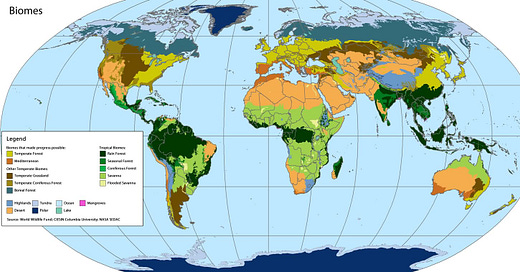


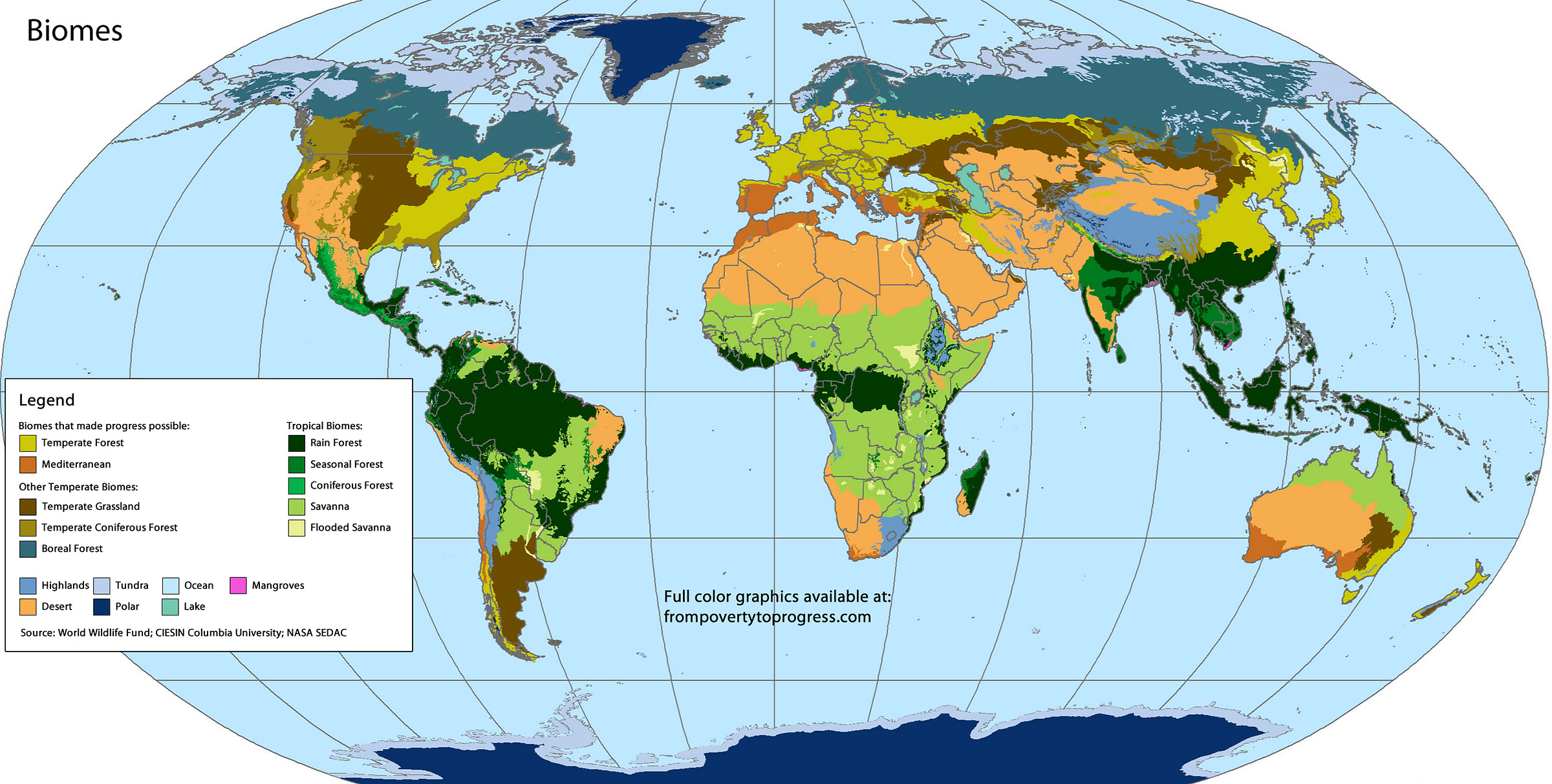






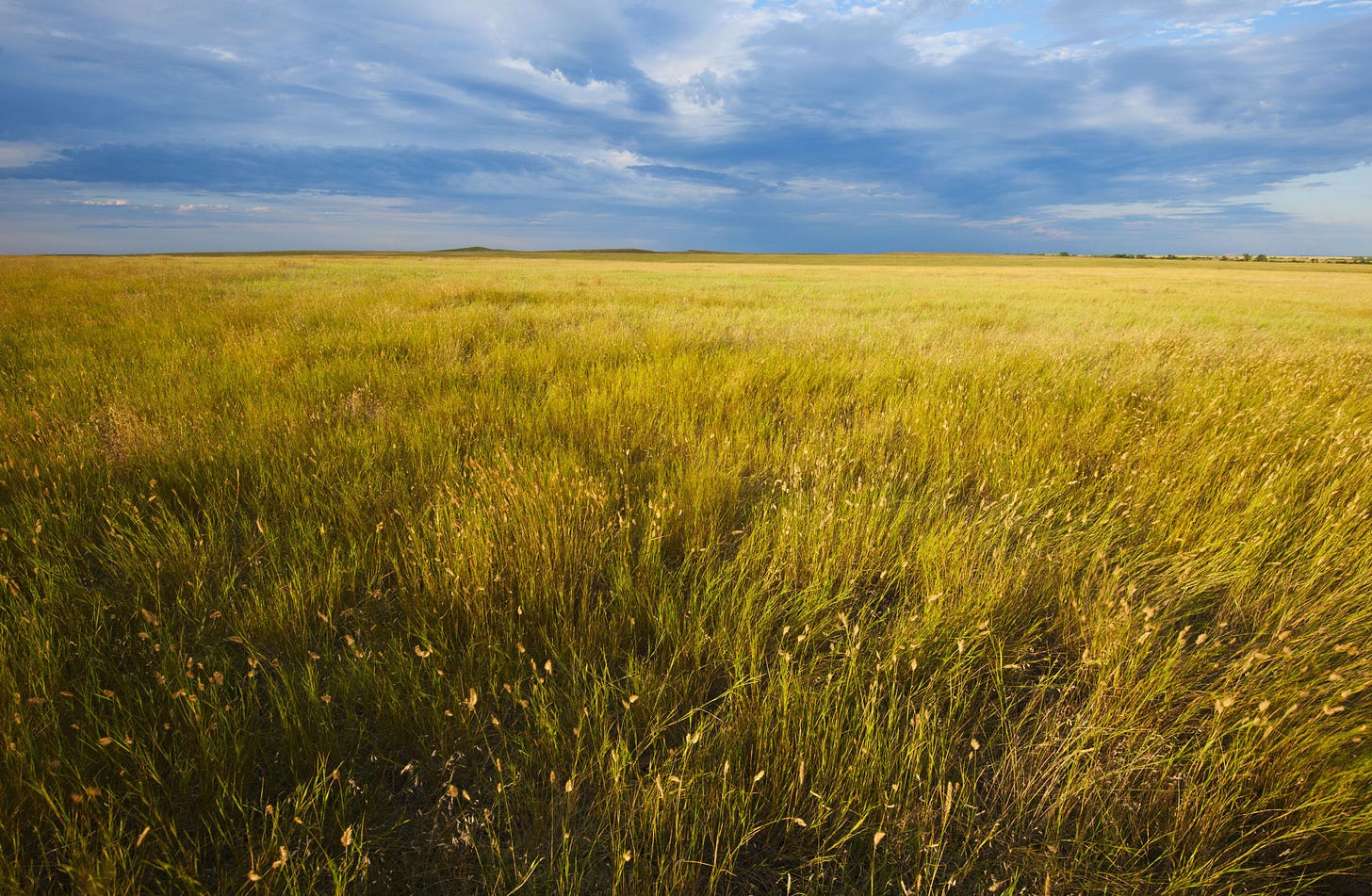
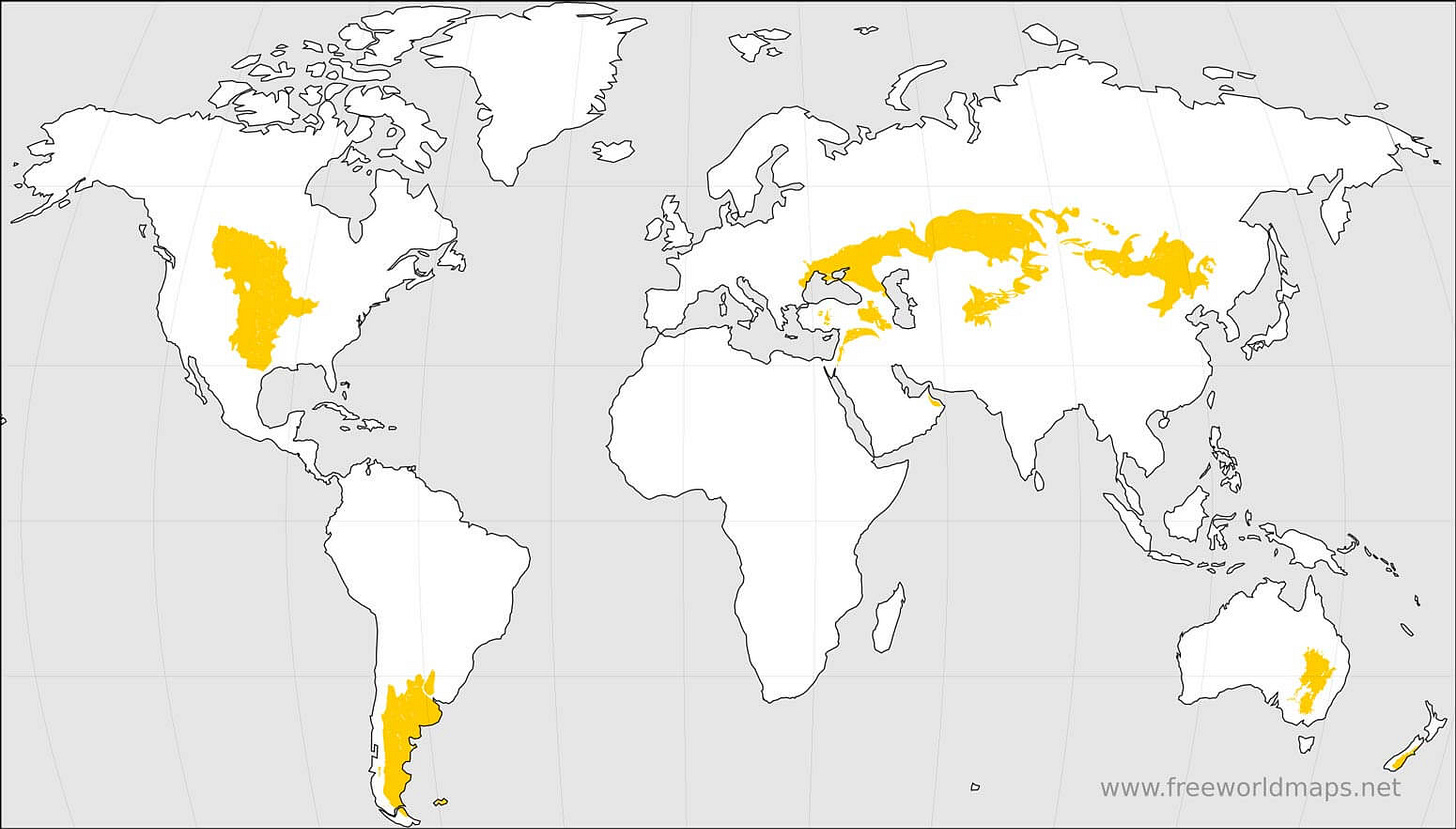





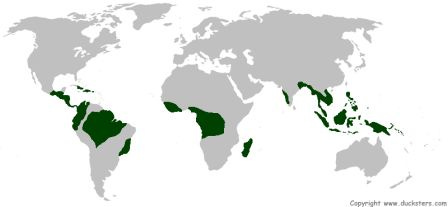
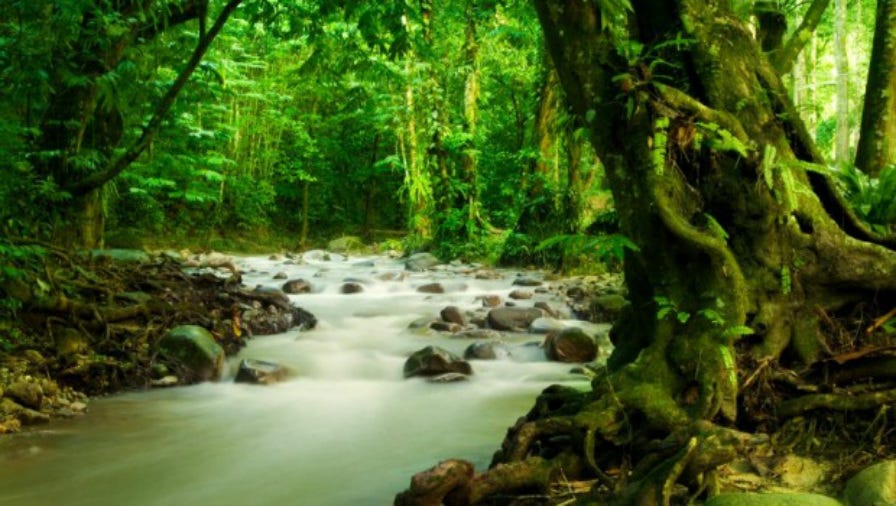
This is an absolutely phenomenal summary of something most of the other writers on progress just take for granted. Thank you!
"Unfortunately, Savanna herbivores are often aggressive and ill-tempered, making domestication impossible. Horses, cows, pigs, sheep, goats and other domesticated mammals all originated in Temperate latitudes."
I wonder if it is a coincidence or if there were reasons for the evolution of these species.